What Lies Under the Skin?—Psi and the Physics of Indeterminacy
I have suggested in previous posts that psi may operate not directly on actual reality, but on the unactualized quantum potential of superposed states prior to physical observation, or what for convenience I call the “Not Yet.” I don’t know if this is a widely held interpretation, although quantum mechanics is felt by many theorists to hold the key to understanding psi in one way or another. It seems eminently reasonable to me that consciousness may have some deep affinity for (or even identity with) the non-actual and could be constantly interacting with it.
Anything that remains unobserved is still indeterminate, and this should render even large portions of the past subject to change. Behind the surface of what already exists there must be vast reserves of unobserved potentiality.
Such a notion not only would account for psi but also preserve free will in a non-causally-closed universe, which is crucial given my opposition to the Minkowski glass block universe in which the future somehow already exists. Even though Slavoj Žižek is a die-hard materialist opposed to all manner of “New Age obscurantism” (which would certainly include the woo I spout on this blog), I agree with his argument in The Parallax View against attempts to neatly sew up philosophical and scientific contradictions via pop-Taoist yin/yang symmetries or Jungian archetypes. The dualities of life, including the future and past, exist in an anamorphic, irreconcilable, non-sew-up-able state; nothing adds up, and there is an instability and indeterminacy even in what seems most secure and definitive. This ultimate non-closure and non-self-identity (Buddhist “no self”) is what enables free will to exist; the human subject is an agent participating in making reality through observation—the Copenhagen Interpretation of quantum mechanics insists on this. The future thus cannot exist fully formed “out there” in some preexisting Platonic realm.
Where I depart from Žižek is in suggesting that this asymmetry and non-closure even includes the existent past. The past can really be changed, and not just in its retroactive framing via the ever-shifting Symbolic (which I suggest is just Žižek’s materialistic evasion of paranormal possibilities like precognition). As Richard Shoup writes (in his contribution to the excellent new collection Extrasensory Perception edited by Edwin May and Sonali Bhatt Marwaha), “in the quantum realm, possibilities are ‘real’ and can interact to have real effects.” If psi is an interaction with these possibilities prior to their physical observation, it could explain both precognitive phenomena and psychokinetic (PK) effects, and even “retro-PK” effects: Anything that remains unobserved is still indeterminate, and this should render even large portions of the past subject to change. Behind the surface of what already exists there must be vast reserves of unobserved potentiality.
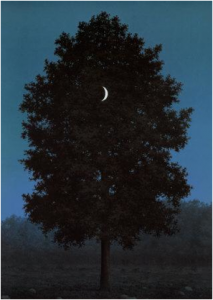 The possibility that focused attention can actually alter the past has been explored experimentally—for instance, Helmut Schmidt’s work with retroactively altering the outcome of random number generators. In his book First Sight, James Carpenter argues that psi—including both ESP and PK—is an intrinsic (albeit largely unconscious) part of our everyday functioning. If so, and if psi involves some kind of unconscious tampering with the latent potential of quantum superposed states prior to physical observation, then we may be continually traversing the Forbidden Zone of the Not Yet and thereby creating our own order and moving toward it, hidden even from the eyes of God and Heisenberg. In other words, we are not only reacting to our probable futures through some unconscious precognitive channel; we may even, without knowing it, be setting up opportunities and obstacles for ourselves that could affect our future outcomes by meddling in the past via our attention or our intention.
The possibility that focused attention can actually alter the past has been explored experimentally—for instance, Helmut Schmidt’s work with retroactively altering the outcome of random number generators. In his book First Sight, James Carpenter argues that psi—including both ESP and PK—is an intrinsic (albeit largely unconscious) part of our everyday functioning. If so, and if psi involves some kind of unconscious tampering with the latent potential of quantum superposed states prior to physical observation, then we may be continually traversing the Forbidden Zone of the Not Yet and thereby creating our own order and moving toward it, hidden even from the eyes of God and Heisenberg. In other words, we are not only reacting to our probable futures through some unconscious precognitive channel; we may even, without knowing it, be setting up opportunities and obstacles for ourselves that could affect our future outcomes by meddling in the past via our attention or our intention.
The possibilities could go well beyond the implications for our personal fates. Interacting with the quantum Not Yet may be the ‘secret’ in various ancient alchemical, magical, or shamanic practices. Such retroactive effects may be exploited for healing, for instance, and may be the mechanism involved in nontraditional or spiritual curing modalities (see below). Although scandalous to the materialistically minded, it is not really such a far-out idea, if you have any magical inclinations: Such meddling in the unseen/hidden is what the occult means, after all.
”Pulsing slowly with inchoate life”
Folklore, myth, and art have produced many ways of personifying the abhorrent/fascinating notion that the past is not safely buried and that inert matter may hold weird and awesome surprises in its dark heart. In my last post I mentioned Oedipus as a kind of time traveler, but vampires and other undead creatures are also classic representations of the idea of the fixed (i.e., “dead”) past somehow still subject to change because of a latent unseen potential still lurking under the skin: Despite being inert, cold, and lifeless, a vampire is paradoxically alive, animated by and seeking out a vital energy, symbolized by the blood of the living, especially of youth.
The obvious fact that our bodies are not transparent creates worlds of possibility within us, vast reserves of Not Yet for psi to exploit.
The psychoanalyst Jacques Lacan made such a hidden, unsymbolized-yet-vital domain central to his theory of the human condition: The Real is that which is unspeakable, unknowable, not even actually existing, yet uncannily and outrageously still exerting a tangible effect. It is the very model of the sacred, the impossible acausal cause, and it is the home of jouissance, the excessive painful enjoyment that is “the only substance acknowledged by psychoanalysis.” Jouissance is that blood of youth that keeps the vampire alive, and, I have argued, it is a better candidate than “trauma” for the carrier of precognitive information about our own future. Lacan’s understanding of the psychoanalytic cure was having the patient traverse the fantasy keeping them in ignorance of their enjoyment, thus implicitly carrying them closer to the (terrifying) Real.
 One of Žižek’s favorite illustrations of the Real is a 1942 Robert Heinlein story, “The Unpleasant Profession of Jonathan Hoag”: The title character comes to learn that our universe is only one of a plurality of universes created as works of art by mysterious beings, and that he himself has been assigned by an evil lesser divinity to corrupt our world. Hoag informs his friends of his mission and lets them know that, later that day, he will be fixing a few minor blemishes in reality that he has discovered; he warns his friends not to open their windows or look outside during the minutes when he will be making these fixes. When Hoag’s friends of course do roll down the window of the cab they are riding in, despite his warning, they see a “formless gray flux” where their view of the city had been, “pulsing slowly as if with inchoate life.” This, Žižek says, is the Real—”the pulsing of the pre-symbolic substance in all its abhorrent vitality.”
One of Žižek’s favorite illustrations of the Real is a 1942 Robert Heinlein story, “The Unpleasant Profession of Jonathan Hoag”: The title character comes to learn that our universe is only one of a plurality of universes created as works of art by mysterious beings, and that he himself has been assigned by an evil lesser divinity to corrupt our world. Hoag informs his friends of his mission and lets them know that, later that day, he will be fixing a few minor blemishes in reality that he has discovered; he warns his friends not to open their windows or look outside during the minutes when he will be making these fixes. When Hoag’s friends of course do roll down the window of the cab they are riding in, despite his warning, they see a “formless gray flux” where their view of the city had been, “pulsing slowly as if with inchoate life.” This, Žižek says, is the Real—”the pulsing of the pre-symbolic substance in all its abhorrent vitality.”
I don’t know whether Heinlein was knowingly alluding to quantum physics, but his “formless gray flux” seems precisely to represent the “spread-out smear” of non-actualized quantum potentials. More recently, Žižek has described the inscrutable equations of quantum mechanics as a manifestation of the Real—simply because those equations are intimidating gibberish to most of us—but clearly the “abhorrent” (to a mechanistic materialist) smear of indeterminacy itself is really where the Real is at.
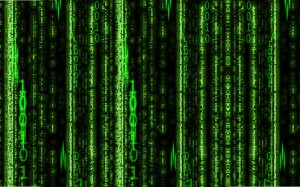 Almost as if to illustrate my proposal that this flux may be directly manipulated or reprogrammed, Hoag’s editorial emendations of reality work through this non-public-facing “quantum back end.” His intervention may look to us today very much like an administrative change to a website, or the Matrix, but the Real does not consist (ultimately) of strings of green numbers tumbling in black space. It is profoundly non-symbolic, not a code, and not even informational in the usual sense. The Real/Not Yet is a domain prior to information as such. This is why, instead of (or in addition to) a “physics of information,” we may find a physics of the indeterminate Real to be more helpful for understanding the more mysterious aspects of our world.
Almost as if to illustrate my proposal that this flux may be directly manipulated or reprogrammed, Hoag’s editorial emendations of reality work through this non-public-facing “quantum back end.” His intervention may look to us today very much like an administrative change to a website, or the Matrix, but the Real does not consist (ultimately) of strings of green numbers tumbling in black space. It is profoundly non-symbolic, not a code, and not even informational in the usual sense. The Real/Not Yet is a domain prior to information as such. This is why, instead of (or in addition to) a “physics of information,” we may find a physics of the indeterminate Real to be more helpful for understanding the more mysterious aspects of our world.
Occult Forces
The body, for example, is a deeply mysterious place. Its obstinate opacity, the simple fact that our skin and flesh make it impossible to see the condition of things underneath, remains one of the biggest challenges to medicine, which is forced to rely on dangerous radiological methods for observation—methods that may raise the risk for the very diseases (e.g., cancers) that they are probing for. On the other hand, the body’s opacity may be one of its most fundamental advantages, from a psi standpoint. The obvious fact that our bodies are not transparent (like those of some deep sea animals) creates worlds of possibility within us, vast reserves of Not Yet for psi to exploit.
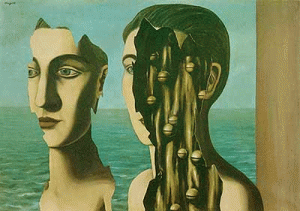 Based on a very suggestive article by William Braud on the possibility of targeting past states of incipient illness through a kind of retro-PK a la Helmut Schmidt, Russell Targ (in Limitless Mind) has described a target of psychic healing as effecting a change within the body while sickness is still vague and indeterminate, before a firm diagnosis is “locked in” through observation (for instance, in an X-ray or surgical procedure that makes the source of the illness visible). “Primitive” cures may (according to this notion) be the deft exploitation or even recruitment of quantum superposition through psychic effects, recruitment of unconscious mind-body connection, and correctly timed real-world observation. In other words, shamanism may be the art of cultivating or shepherding the emergence of desired actualities through careful timing of concealment and disclosure.
Based on a very suggestive article by William Braud on the possibility of targeting past states of incipient illness through a kind of retro-PK a la Helmut Schmidt, Russell Targ (in Limitless Mind) has described a target of psychic healing as effecting a change within the body while sickness is still vague and indeterminate, before a firm diagnosis is “locked in” through observation (for instance, in an X-ray or surgical procedure that makes the source of the illness visible). “Primitive” cures may (according to this notion) be the deft exploitation or even recruitment of quantum superposition through psychic effects, recruitment of unconscious mind-body connection, and correctly timed real-world observation. In other words, shamanism may be the art of cultivating or shepherding the emergence of desired actualities through careful timing of concealment and disclosure.
Paranormal phenomena might not simply fall between our epistemic cracks, but could actually be effects of such cracks, materializations of impossibility.
There is much in the literature of European alchemy to suggest that this idea was also part of the Hermetic tradition. The “fertility” (i.e., potential) of what remains hidden or in the dark (i.e., unobserved) is one of the central themes of Fulcanelli’s 1927 masterpiece, Le Mystere de Cathedrales, one of the most seductive alchemical texts of modern times or of any time. Early in the book, describing the subterranean chambers beneath Gothic cathedrals, he writes: “Real, but occult, power, which is exercised in secret, develops in the darkness, toils without respite in the deep foundations of the work.” He circles back and develops this idea at greater length, very provocatively, later on:
What, then, is this primordial condition, which is essential if any generation is to take place? I will reply on your behalf: the total absence of any solar light, even when diffused or filtered. Look around you, consult your own nature. Do you not see that with man and with animals, fecundation and generation take place, thanks to a certain disposition of organs, in complete obscurity, maintained until the time of birth? … There is no process, even down to the work of digestion … which does not take place in the dark. … I know, myself, that the goddess Isis is the mother of all things, that she bears them all in her womb and that she alone can bestow Revelation and Initiation.
 Isis was the Egyptian prototype of Mary, and the Black Madonnas found in some cathedral crypts reflect this ancient symbol of what could be called the “womb of the Real,” the occult quantum potential from which the Actual (the Stone/Christ) is delivered. The alchemist could be seen as sort of a skilled midwife, helping coax into reality something latent in nature but ordinarily unexpressed or imperfectly expressed. The maternal symbolism goes to the heart of the Hermetic project, where the primordial chaos to be transformed into the philosopher’s stone is called the Prima Materia—the “first matter” which is also “first mother.”
Isis was the Egyptian prototype of Mary, and the Black Madonnas found in some cathedral crypts reflect this ancient symbol of what could be called the “womb of the Real,” the occult quantum potential from which the Actual (the Stone/Christ) is delivered. The alchemist could be seen as sort of a skilled midwife, helping coax into reality something latent in nature but ordinarily unexpressed or imperfectly expressed. The maternal symbolism goes to the heart of the Hermetic project, where the primordial chaos to be transformed into the philosopher’s stone is called the Prima Materia—the “first matter” which is also “first mother.”
Throughout alchemy, the interaction between lunar, feminine, indeterminate darkness and solar, masculine, definitive light or knowledge, was the central archetypal “dance” or interplay, skilfully orchestrated by the adept. Again, as in shamanism, alchemy—which Fulcanelli calls the “art of light”—is not simply “enlightenment” (as Buddhist or Tantric interpreters may understand it) but rather knowing when and for how long to keep things hidden, knowing the proper time to disclose or reveal (i.e., shed light) in order to, again, properly give birth to some possibility that is already latent within matter. Thus, “occult” in the Hermetic sense is not only a matter of keeping secrets from the rabble, but a whole ontology of the Real as what exists prior to knowledge, “light,” and symbolization.
Hinting more directly at the quantum nature of Hermetic practice, Fulcanelli’s colleague (and possibly alter-ego) Rene Schwaller de Lubicz described alchemy as being fundamentally a matter of “perception and gesture,” implying that the key to alchemical creation really lies in a certain way of seeing (i.e., way of observing), as well as a knack for timing certain crucial disclosures. This may involve an occult way of knowing that can penetrate the darkness without light, concretely symbolized by the “rose windows” that dimly illuminate the interior of a cathedral and shed spiritual light on the Mass. This form of knowing, best accessed at night (don’t forget the esoteric meanings of “rose” I discussed in an earlier post), seems to involve upsetting or scrambling the very order of Time and its customary sequences, and reminds me very much of psi.
In imitation of the ever-mysterious Fulcanelli, I will say no more on this subject.*
The Power of Luv
George Hansen has observed that paranormal phenomena all fall within the interstices of our cultural categories; using the terminology of structuralist anthropology, he calls them “anti-structural” (or liminal) phenomena. Lacan’s Real, as the domain outside or beyond the Symbolic, is the equivalent of anti-structure, and I think it provides an even better conceptual framework for understanding the paranormal in all its blurred-together, impossible, absurd forms.
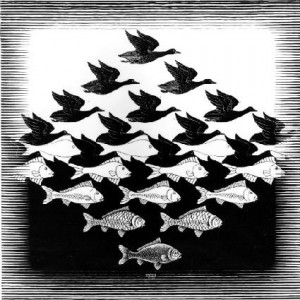 Although often characterized as an actually existing world beyond or underneath the Symbolic, Žižek came to interpret the Real as an insubstantial mirage produced by parallax, the shimmering rift between the Symbolic and Imaginary, a pure semblance or illusion, but one that nevertheless produces a real effect. (Late in his Exegesis, Phil Dick developed a philosophical category that he called the “surd,” exactly like the Real, which he also linked to a parallactic or “Ditheon” mode of perception: The surd is a nothing, a flicker in the inconsistent fabric of the universe, vanishing before it even appears, yet uncannily exerting a tug or pull on reality anyway.) This parallactic understanding of the Real offers a new way of thinking about paranormal phenomena: that they might not simply fall between our epistemic cracks, but could actually be effects of such cracks, perhaps even materializations of impossibility, like those Magritte or Escher images in which the negative space between objects become objects themselves.
Although often characterized as an actually existing world beyond or underneath the Symbolic, Žižek came to interpret the Real as an insubstantial mirage produced by parallax, the shimmering rift between the Symbolic and Imaginary, a pure semblance or illusion, but one that nevertheless produces a real effect. (Late in his Exegesis, Phil Dick developed a philosophical category that he called the “surd,” exactly like the Real, which he also linked to a parallactic or “Ditheon” mode of perception: The surd is a nothing, a flicker in the inconsistent fabric of the universe, vanishing before it even appears, yet uncannily exerting a tug or pull on reality anyway.) This parallactic understanding of the Real offers a new way of thinking about paranormal phenomena: that they might not simply fall between our epistemic cracks, but could actually be effects of such cracks, perhaps even materializations of impossibility, like those Magritte or Escher images in which the negative space between objects become objects themselves.
Thus the sub-question beneath that of psychically intervening in the quantum Real is this: Could it be possible to manifest this no-thing in consensus reality, perhaps shamanically, alchemically, or psychically, so that it could be shared and perceived? Is this somehow the answer to alchemical creativity, the “something from nothing” promised by the ancient mysteries? The Jungian idea, for instance, is that UFOs are somehow manifestations of the collective unconscious in a time of cultural shift; what if we reframe this slightly and suggest that UFOs are manifestations of Symbolic-Imaginary “negative space”—conceptual gaps and discontinuities that under certain psychologically intensified conditions can manifest as solid, existent, objects ‘standing out’ in the world? In Messengers of Deception, Jacques Vallee offers such an occult possibility as one that should at least be considered.
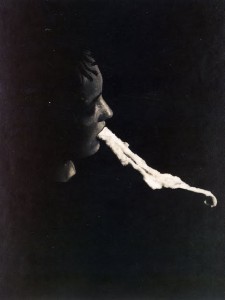 Various magical traditions describe the ability to create thought-forms; Vallee mentions tulpas, the materialized imaginal beings of Tibetan Buddhist magic. Buddhist orthodoxy declares that these are stabilized hallucinations in the mind of the creator, meant to give insight into the fact that all of reality is mind-created. The ritual magic tradition typically also explains the creation of such forms as manifestations in a psychic interspace (the astral plane) rather than in physical reality, although the folklore surrounding the Jewish mysticism that fed that tradition spoke of animated protoplasmic beings (i.e., golems) running amok in real life. Perhaps less ambitiously, various spiritual traditions also speak of spectral bodily fluids that manifest on the edge of reality or in altered states of consciousness, and seem like similar conjurings of the stuff of the Real out of thin air.
Various magical traditions describe the ability to create thought-forms; Vallee mentions tulpas, the materialized imaginal beings of Tibetan Buddhist magic. Buddhist orthodoxy declares that these are stabilized hallucinations in the mind of the creator, meant to give insight into the fact that all of reality is mind-created. The ritual magic tradition typically also explains the creation of such forms as manifestations in a psychic interspace (the astral plane) rather than in physical reality, although the folklore surrounding the Jewish mysticism that fed that tradition spoke of animated protoplasmic beings (i.e., golems) running amok in real life. Perhaps less ambitiously, various spiritual traditions also speak of spectral bodily fluids that manifest on the edge of reality or in altered states of consciousness, and seem like similar conjurings of the stuff of the Real out of thin air.
One of the fascinating obsessions in Terence McKenna’s account of his experience in Amazonia, True Hallucinations, is the mysterious violet, blue, or black fluid that Amazonian shamans are reputed to vomit and/or sweat during Ayahuasca ceremonies and then use for divination and magic, not unlike the ambiguous “ectoplasm” of Victorian spiritualism (above): “These matters are extremely secret,” McKenna writes:
Informants insist that the shamans spread the stuff out on the ground in front of them, and that one can look into this material and see other times and other places. According to their reports, the nature of this fluid is completely outside of ordinary experience: it is made out of space/time or mind, or it is pure hallucination objectively expressed but always keeping itself within the confines of a liquid.
McKenna’s desire to learn about this stuff stems partly from his own earlier experience in Tibet, during a DMT-fueled sexual encounter with a British woman:
Then I saw that where our bodies were glued together there was flowing, out of her, over me, over the floor of the roof, flowing everywhere, some sort of obsidian liquid, something dark and glittering, with color and lights within it. … What was this fluid and what was going on? I looked at it. I looked right into it, and it was the surface of my own mind reflected in front of me. Was it translinguistic matter, the living opalescent excrescence of the alchemical abyss of hyperspace, something generated by the sex act performed under such crazy conditions? … I christened the obsidian fluid we had generated ‘luv,’ something more than love, something less than love, perhaps not love at all, but some kind of unplumbed potential human experience very little is known about.
Translinguistic matter … an unplumbed potential human experience that very little is known about… Although McKenna says he had smoked DMT, I suspect someone had actually slipped some Lacan into his pipe. That obsidian-black matter beyond language, called “luv,” released in an act of bliss and acting as the medium of nonlocal information, sounds like nothing other than materialized jouissance, released in the rapturous rupture of the Symbolic order.**
Coagulating Jouissance
Is it perhaps possible for jouissance to spatially ‘materialize’ in some strange way or under certain circumstances, as an outcome of the temporal reordering implied by psi perception? In previous posts I have described how misrecognized precognition could create an atemporal feedback loop that adds gravitational weight (i.e., meaning) to a minor coincidence, thus producing what people experience in hindsight as a synchronicity. What if, on analogy with this, there could be an “aspatial” feedback loop that gives material density (or the appearance of density) to an idea, which through a similar chicken-and-egg tautological logic of being observed before it comes into being, feeds back on the prior observation, taking on a kind of temporary, palpable solidity or substantiality?
How many “impossible” paranormal phenomena might be the result of acausal bootstrapping of reality via psi? Is this what created (or, precipitated) the universe to begin with? Was God just a mega-shaman who drew the universe out of his dark chest as a kind of cosmological phlegm?
This admittedly crazy-sounding idea occurred to me not long ago after staring at a duck/rabbit image I have tacked up on my office wall. As I described in my “Rashomon Mind” post several months ago, I was doing this exercise in hopes that I could eventually make the image stabilize on a neither/nor state, thereby defeating or neutralizing the duck/rabbit’s oscillating force. I would thus triumphantly disprove a century of psychological doctrine that the mind cannot tolerate contradiction. It has proved harder than I expected, and my results are still inconclusive. What I did not expect, however, and what astonished me, were certain brief visions that this practice generated … including briefly seeing the duck/rabbit as a solid, 3-D object pushing out of the paper.
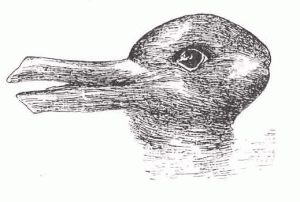 Weirdly, I could briefly not only see but mentally “feel” the duck/rabbit’s solidity in space, like a heavy 5-inch-long lump of gray metal. This was a typically fleeting ’Solaris-Mind’-type vision or hallucination, gone in a split second, but I suspect that this ‘felt sense’ of a solid physical object in one’s presence, as a result of meditation on a model of a desired object, could be the basis of tulpa experiences in much more adept meditators, or thought forms for adept magicians. I don’t know, but perhaps it could also be the basis for palpably experienced magical phlegm described by McKenna. When you stare at something long enough, you hallucinate it in a new, weird way.
Weirdly, I could briefly not only see but mentally “feel” the duck/rabbit’s solidity in space, like a heavy 5-inch-long lump of gray metal. This was a typically fleeting ’Solaris-Mind’-type vision or hallucination, gone in a split second, but I suspect that this ‘felt sense’ of a solid physical object in one’s presence, as a result of meditation on a model of a desired object, could be the basis of tulpa experiences in much more adept meditators, or thought forms for adept magicians. I don’t know, but perhaps it could also be the basis for palpably experienced magical phlegm described by McKenna. When you stare at something long enough, you hallucinate it in a new, weird way.
In my synchronicity model—and this continues to be borne out in my observation of precognitive dreams—a central role is often played by trivial/mundane coincidence, which serves to make a future event, or multiple future events, into a seed around which the synchronicity forms. In what I’m describing here, some brief expectation or misperception could serve, similarly, as the nucleus of the effect. Such a thing could explain the theatrics and fraud that seems to be common in the study of even ‘genuine’ mediums and psychics. A little bit of fraud or trickery to implant the expectation not only in others’ minds but also in one’s own mind could be a necessary seed to facilitate the conjuring of the substance of the Real out of the void, perhaps utilizing the “group effect” of shared expectation.
McKenna’s “luv” seems like such a possible materialization: transitory and flickering, mirage-like, because it is a contradiction, arising from a paradoxical “loop” in the atemporal dimension of substance, mass, and meaning—a kind of intensification of the Real, generating itself as a cause, vanishing as a mirage afterward.
As in the self-confirming circular causation of synchronicity, a thought form conjured literally out of nothing could contribute to the mental state that gives rise to it—at least temporarily, while the conditions are exactly right, before evaporating. If a mental state of ‘anticipation-of-seeing-X’ could be produced and stabilized by a talented trickster/shaman, a drug, or a piece of sophisticated illusionistic or mind-control technology, it might have the effect of actually temporarily manifesting an object that fulfills observers’ expectations, perhaps even exerting real causal effects in the world before it evaporates; a UFO or similar manifestation could actually feed on the strong emotional reactions of witnesses in order to take form. Could this explain the theatrical aspects of some UFO sightings and apparitions?
 The question is, again, would such a thing be only a hallucination? It is one thing to trick oneself or maybe a small group of intoxicated people in the dim candle- or moonlight into seeing something compelling, but could there be “real reality” to these fleeting visions? It sounds preposterous on one level, yet it occurs to me that the paradoxical substance of enjoyment, conjured into existence through careful manipulation of personal totems, would be a kind of shamanic model, in miniature, of how matter might arise as a product of contradiction in a parallactic relativistic universe where no two realities are alike and the future and past don’t neatly join along a nice seam.
The question is, again, would such a thing be only a hallucination? It is one thing to trick oneself or maybe a small group of intoxicated people in the dim candle- or moonlight into seeing something compelling, but could there be “real reality” to these fleeting visions? It sounds preposterous on one level, yet it occurs to me that the paradoxical substance of enjoyment, conjured into existence through careful manipulation of personal totems, would be a kind of shamanic model, in miniature, of how matter might arise as a product of contradiction in a parallactic relativistic universe where no two realities are alike and the future and past don’t neatly join along a nice seam.
By creating contradiction and intensifying it in the confined theaterlike setting of a shamanic ceremony/performance, might creation ex nihilo be what the most gifted shamans and ectoplasm spiritualists are demonstrating? Is this what Fulcanelli was hinting at, when he said he knew that all things emerge from the womb of Isis? Very suggestively, the central concept in Rene Schwaller’s Hermetic theory is Salt (part of the classical alchemical triad with Sulfur and Mercury), which he describes as having a “styptic”—that is, coagulating—function. By “Salt” is he referring to light or observation itself (i.e., perception) as ‘coagulating’ a desired state of matter out of the quantum potential, perhaps by carefully timing the moment of observation? Or is he referring to some literal conjuring of matter out of nothing, out of the primal chaos of the Real, the Buddhist void of no-self itself?
I wonder if psi is the basis of this, and could enable an acausal ‘bootstrapping’ of reality. Is this bootstrapping what created (or, precipitated) the universe to begin with? Was God just a mega-shaman who drew the universe out of his dark chest as a kind of cosmological phlegm?
POSTSCRIPT: Woman Does Not Exist
 The latent potentiality in seemingly fixed matter is, as I mentioned, figuratively a kind of “fertility,” and thus the quantum domain behind the veneer of the actual is especially entangled with the idea of femininity and maternal enjoyment. I argued that the Oedipus myth expresses the taboo and hubris of meddling magically with the non-actual, but the punishment for such (male) hubris is also perhaps the latent meaning in Jonathan Glazer’s masterpiece, Under the Skin, my favorite science fiction film of the past few years.
The latent potentiality in seemingly fixed matter is, as I mentioned, figuratively a kind of “fertility,” and thus the quantum domain behind the veneer of the actual is especially entangled with the idea of femininity and maternal enjoyment. I argued that the Oedipus myth expresses the taboo and hubris of meddling magically with the non-actual, but the punishment for such (male) hubris is also perhaps the latent meaning in Jonathan Glazer’s masterpiece, Under the Skin, my favorite science fiction film of the past few years.
 Scarlett Johansson plays a cold ‘alien’ (of some sort, though her origin and her mission are unclear) who seduces men on the streets of Glasgow, luring them to their doom. The black petroleum-like medium into which she draws her would-be lovers, and their hallucinatory “experience” as they hang suspended in it, somehow out of Time, distinctly call to mind the translinguistic bodily fluid that obsessed McKenna. Seeing that the alien’s “true self” is made of the same black grease-like substance, we realize that it may somehow be her very body, the ‘feminine body of enjoyment,’ that her victims are absorbed and trapped in.
Scarlett Johansson plays a cold ‘alien’ (of some sort, though her origin and her mission are unclear) who seduces men on the streets of Glasgow, luring them to their doom. The black petroleum-like medium into which she draws her would-be lovers, and their hallucinatory “experience” as they hang suspended in it, somehow out of Time, distinctly call to mind the translinguistic bodily fluid that obsessed McKenna. Seeing that the alien’s “true self” is made of the same black grease-like substance, we realize that it may somehow be her very body, the ‘feminine body of enjoyment,’ that her victims are absorbed and trapped in.
 My distant second favorite sci-fi film of the past couple years, Ex Machina, came out over a year after Under the Skin but resembles it in so many details*** that I think they need to be seen as Levi-Straussian permutations of the same underlying myth. The fact that “alien” can be substituted with “robot” shows that, on one level, that myth isn’t about anything science-fictional, but about femininity as a problem of surface (skin) in relation to depth. They are films about the basic idea that, as Lacan put it, “Woman does not exist.” He didn’t mean women do not exist, obviously; he meant that in our psychic landscape, femininity and womanhood represent precisely indeterminacy, fluidity, and dependence on observation to become Actual.
My distant second favorite sci-fi film of the past couple years, Ex Machina, came out over a year after Under the Skin but resembles it in so many details*** that I think they need to be seen as Levi-Straussian permutations of the same underlying myth. The fact that “alien” can be substituted with “robot” shows that, on one level, that myth isn’t about anything science-fictional, but about femininity as a problem of surface (skin) in relation to depth. They are films about the basic idea that, as Lacan put it, “Woman does not exist.” He didn’t mean women do not exist, obviously; he meant that in our psychic landscape, femininity and womanhood represent precisely indeterminacy, fluidity, and dependence on observation to become Actual.
Woman is thus Real, the exact equivalent of the quantum Not Yet, and thus these films carry forward the ancient alchemical “lunar” archetype. When the jet-black alien is revealed at the end of Under the Skin (top of this post), she could just as well be one of those Isis/Madonnas in the cathedral crypts described by Fulcanelli.
 Ex Machina is being discussed as an interesting exploration of artificial intelligence, although really there is nothing that original about the questions it poses—the same questions were asked in Blade Runner 35 years ago, and that film resolved with similar rich ambiguities. What Blade Runner rightly emphasized, and Ex Machina failed to, was that consciousness is a matter of feeling (that is, sentience, not just “intelligence”), which is linked crucially to embodiment, including the body’s capacity for enjoyment and emotional responses (e.g., Roy Batty’s “We’re not computers, Sebastian, we’re physical.”).
Ex Machina is being discussed as an interesting exploration of artificial intelligence, although really there is nothing that original about the questions it poses—the same questions were asked in Blade Runner 35 years ago, and that film resolved with similar rich ambiguities. What Blade Runner rightly emphasized, and Ex Machina failed to, was that consciousness is a matter of feeling (that is, sentience, not just “intelligence”), which is linked crucially to embodiment, including the body’s capacity for enjoyment and emotional responses (e.g., Roy Batty’s “We’re not computers, Sebastian, we’re physical.”).
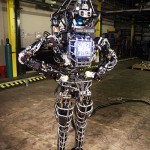 The emphasis on Turing Tests and artificial intelligence in Ex Machina basically skips over the real “hard problem” of why it is so hard to build a realistically functioning android body in real life, as evidenced from the ongoing DARPA-funded efforts. It’s not Ava’s brain we should be focused on, in other words, but her physical form—and indeed, that is exactly what we are focused on, despite the film’s various efforts to clothe that interest in philosophical problems. How might the film have been different, and possibly more interesting, if Ava were unattractive, overweight, and clumsy, not unlike the robots that tripped and stumbled through the recent, sadly funny DARPA Robotics Challenge?
The emphasis on Turing Tests and artificial intelligence in Ex Machina basically skips over the real “hard problem” of why it is so hard to build a realistically functioning android body in real life, as evidenced from the ongoing DARPA-funded efforts. It’s not Ava’s brain we should be focused on, in other words, but her physical form—and indeed, that is exactly what we are focused on, despite the film’s various efforts to clothe that interest in philosophical problems. How might the film have been different, and possibly more interesting, if Ava were unattractive, overweight, and clumsy, not unlike the robots that tripped and stumbled through the recent, sadly funny DARPA Robotics Challenge?
Under the Skin, on the other hand, doesn’t make any pretenses about its core mysteries, and when Scarlett Johansson scrutinizes her nude body in the mirror near the end, there is real questioning, because what is under the skin is actually unknown, unexplained, and deeply confusing.
So in some sense, Ex Machina is not just a permutation: It is a materialistic bowdlerization of the messy, dirty mystery examined in Under the Skin. The supposed issue at stake, whether consciousness can be created artificially, is itself “the magician’s hot assistant” (to use the metaphor the film itself provides) to keep us from seeing that our real interest is actually in, and should be in, the magician’s hot assistant, not the magic trick. (As Žižek puts it, “a thing is its own best mask.”) That’s because it is the hot assistant’s body that contains the Real, feminine, physical mystery, “how something can arise from nothing”—which in different ways quantum physics, alchemy, and (I argue) Lacanian psychoanalysis all suggest has to do with jouissance and its potential ability to reorder Time itself.
###
* … BUT if you’re interested, and would like some crucial enlightenment, you could do worse than securing a copy of Andre VandenBroek’s Al-Kemi, paying attention to the author’s hints about decoding other alchemical classics, and then going back and applying that insight to Fulcanelli’s cathedrals book, paying particular attention to sphinxes that don’t bark in the night, and other Oedipal themes. Did I mention that this was crucial?
Oh no, the Hermetic mafia are knocking on my door! I said too much…
** Stephan Beyer discusses the magical phlegm of Amazonian shamans in his recent book Singing to the Plants. And, interestingly, David Lynch displays knowledge of such a substance in connection to the occult. In his painting “Red Man Does Magic Near His House” (below), the magic man of the title exudes an obsidian black (clearly labeled) “fluid.”
*** You don’t believe Under the Skin and Ex Machina are essentially the same film? One is about a cold beautiful alien with borrowed skin tricking and destroying men in a Northern locale; the other is about a cold beautiful robot with borrowed skin tricking and destroying men in a Northern locale. In both films, the non-women must learn to be human, show warmth, and thus earn the trust and interest of men, via their desires. In both films, the non-woman is initially under the control of a powerful man, who ultimately loses that control (the mysterious motorcyclist in Under the Skin and Nathan in Ex Machina). Both films have a disturbing scene where the non-woman coldly ignores the desperate pleading of a male (the baby on the beach in Under the Skin—one of the more distressing and artful set-pieces in recent cinema—and Caleb banging on the glass as Ava leaves the house in Ex Machina). Then of course there is the penultimate sequence in both films, in which the beautiful non-woman gazes at her nude body in the mirror.
I might add that both films also boldly and sensitively feature men with severe facial deformities (the man with neurofibromatosis Scarlett Johansson seduces in Under the Skin, and Nathan in Ex Machina—assuming you count hipster beards as deformities).
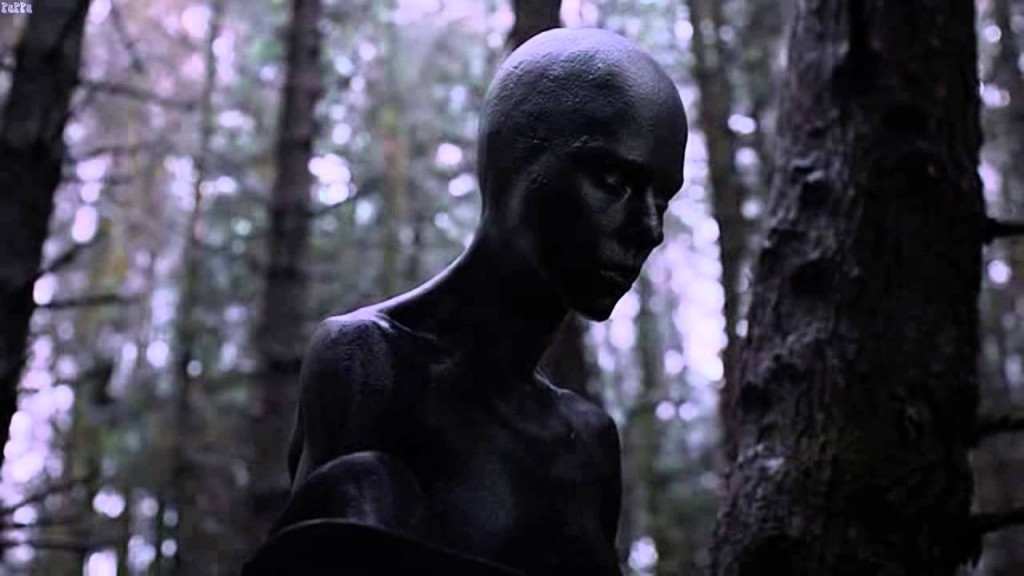
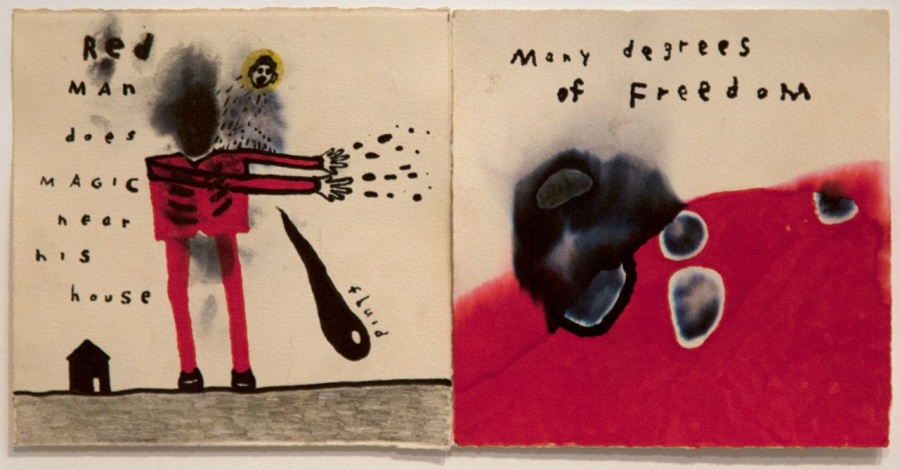





Apologies to everyone who previously commented on this post. My site data was lost and had to be restored from a backup. The comments received on this post could not be restored, unfortunately.